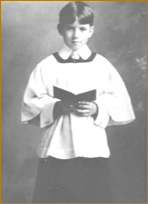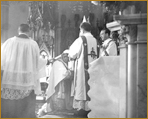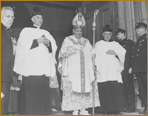|
||||||||||||||||||
Bishop Coleman F. Carroll's wishes were everyone else's commands. When Bishop Carroll took charge of the newly-created Diocese of Miami on October 7, 1958, his flock numbered fewer than 200,000 Catholics spread over 16 counties, exactly half of the state.
Born on February 9, 1905, he was the second of three sons of Irish-born parents.
Coleman was ordained for the Diocese of Pittsburg in 1930, and spent 23 years as a parish priest before being named auxiliary bishop of his home diocese. The years in Miami were turbulent ones: Black Americans' struggle for civil rights and the war in Vietnam shook and almost tore the country apart; Vatican II "opened the windows" and a storm of change engulfed the Catholic Church.
When he died in office 19 years later, the sleepy southern diocese had turned into a booming, bustling, metropolitan See with more than 700,000 Catholics in eight counties, approximately one quarter of the state. |
||||||||||||||||||
| Future >> |
|
||||||||||||||||||
Bishop Coleman F. Carroll's wishes were everyone else's commands. When Bishop Carroll took charge of the newly-created Diocese of Miami on October 7, 1958, his flock numbered fewer than 200,000 Catholics spread over 16 counties, exactly half of the state.
Born on February 9, 1905, he was the second of three sons of Irish-born parents.
Coleman was ordained for the Diocese of Pittsburg in 1930, and spent 23 years as a parish priest before being named auxiliary bishop of his home diocese. The years in Miami were turbulent ones: Black Americans' struggle for civil rights and the war in Vietnam shook and almost tore the country apart; Vatican II "opened the windows" and a storm of change engulfed the Catholic Church.
When he died in office 19 years later, the sleepy southern diocese had turned into a booming, bustling, metropolitan See with more than 700,000 Catholics in eight counties, approximately one quarter of the state. |
||||||||||||||||||
| Future >> |





